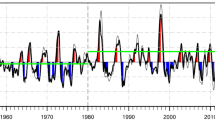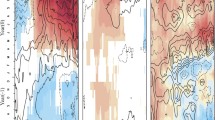Abstract
Through an oceanic mixed-layer heat budget analysis, the dominant processes contributing to the largest decay rate (− 0.37 °C/mon) in EP El Nino, the moderate delay rate (− 0.22 °C/mon) in CP El Nino and the smallest decay rate (0.13 °C/mon) in La Nina, are identified. The result shows that both dynamic (wind induced equatorial ocean waves and thermocline changes) and thermodynamic (net surface solar radiation and latent heat flux changes) processes contribute to a fast decay and thus phase transition in EP El Niño composite, whereas the thermodynamic process has less effect on the decay rate for both CP El Niño and La Niña due to the westward shift of sea surface temperature anomaly (SSTA) centers. Thus, the difference in surface wind stress forcing is critical in contributing to evolution asymmetry between CP El Niño and La Niña, while the difference in both the wind stress and heat flux anomalies contribute to evolution asymmetry between EP El Niño and La Niña. It is interesting to note that El Nino induced anomalous anticyclone over the western North Pacific is stronger and shifts more toward the east during EP El Niño than during CP El Niño, while compared to CP El Niño, the center of an anomalous cyclone during La Niña shifts further to the west. As a consequence, both EP and CP El Niño decay fast and transform into a La Niña episode in the subsequent year, whereas La Niña has a much slower decay rate and re-develops in the second year.








Similar content being viewed by others
References
Alexander MA, Bladé I, Newman M, Lanzante JR, Lau N-C, Scott JD (2002) The atmospheric bridge: the influence of ENSO teleconnections on air-sea interaction over the global oceans. J Clim 15:2205–2231
An SI, Jin FF (2004) Nonlinearity and asymmetry of ENSO. J Clim 17:2399–2412
Burgers G, Stephenson DB (1999) The ‘“normality”’ of El Niño. Geophys Res Lett 26:1027–1030
Carton JA, Giese BS (2008) A reanalysis of ocean climate using simple ocean data assimilation (SODA). Mon Weather Rev 136:2999–3017
Chen M, Li T (2018) Why 1986 El Niño and 2005 La Niña evolved different from a typical El Niño and La Niña. Clim Dyn. https://doi.org/10.1007/s00382-017-3852-1
Chen L, Li T, Yu Y (2015) Causes of strengthening and weakening of ENSO amplitude under global warming in four CMIP5 models. J Clim 28:3250–3274
Chen M, Li T, Shen X, Wu B (2016) Relative roles of dynamic and thermodynamic processes in causing evolution asymmetry between El Niño and La Niña. J Clim 29:2201–2220
Dommenget D, Bayr T, Frauen C (2013) Analysis of the non-linearity in the pattern and time evolution of El Niño southern oscillation. Clim Dyn 40:2825–2847
Held IM, Suarez MJ (1994) A proposal for the intercomparison of the dynamical cores of atmospheric general circulation models. Bull Am Meteorol Soc 75:1825–1830
Jiang XA, Li T (2005) Reinitiation of the boreal summer intraseasonal oscillation in the tropical Indian Ocean. J Clim 18:3777–3795
Kanamitsu M, Ebisuzaki W, Woollen J, Yang S-K, Hnilo JJ, Fiorino M, Potter GL (2002) NCEP-DOE AMIP-II reanalysis (R-2). Bull Amer Meteor Soc 83:1631–1643
Kessler WS (2002) Is ENSO a cycle or a series of events? Geophys Res Lett 29:2125. https://doi.org/10.1029/2002GL015924
Larkin NK, Harrison DE (2002) ENSO warm (El Niño) and cold (La Niña) event life cycles: ocean surface anomaly patterns, their symmetries, asymmetries, and implications. J Clim 15:1118–1140
Latif M, Anderson D, Barnett T et al (1998) A review of the predictability and prediction of ENSO. J Geophys Res 103:14375–14393
Li T (1997) Phase transition of the El Niño-Southern Oscillation: a stationary SST mode. J Atmos Sci 54:2872–2887
Li T, Wang B (1994) A thermodynamic equilibrium climate model for monthly mean surface winds and precipitation over the tropical Pacific. J Atmos Sci 51:1372–1385
Li T, Zhang Y-S, Chang C-P, Lu E, Wang D (2002) Relative role of dynamic and thermodynamic processes in the development of the Indian Ocean dipole: an OGCM diagnosis. Geophys Res Lett 29:2110. https://doi.org/10.1029/2002GL015789
Li T, Wang B, Chang CP, Zhang Y (2003) A theory for the Indian Ocean dipole–zonal mode. J Atmos Sci 60:2119–2135
Li T, Liu P, Fu X, Wang B (2006) Spatiotemporal structures and mechanisms of the tropospheric biennial oscillation in the Indo-Pacific warm ocean regions. J Clim 19:3070–3087
Liebmann B, Smith CA (1996) Description of a complete (interpolated) outgoing longwave radiation dataset. Bull Am Meteor Soc 77:1275–1277
McGregor S, Ramesh N, Spence P, England MH, McPhaden MJ, Santoso A (2013) Meridional movement of wind anomalies during ENSO events and their role in event termination. Geophys Res Lett 40:749–754
Okumura YM, Deser C (2010) Asymmetry in the duration of El Niño and La Niña. J Clim 23:5826–5843
Philander SGH (1990) El Niño, La Niña, and the Southern Oscillation. Academic Press, New York, p 293
Saha S, Nadiga S, Thiaw C et al (2006) The NCEP climate forecast system. J Clim 19:3483–3517
Smith RD, Dukowicz JK, Malone RC (1992) Parallel ocean general circulation modeling. Phsica D 60:38–61
Su J, Zhang R, Li T, Rong X, Kug J-S, Hong C-C (2010) Causes of the El Niño and La Niña amplitude asymmetry in the equatorial eastern Pacific. J Clim 23:605–617
Trenberth KE, Branstator GW, Karoly D et al (1998) Progress during TOGA in understanding and modeling global teleconnections associated with tropical sea surface temperatures. J Geophys Res 103:14291–14324
Wallace JM, Rasmusson EM, Mitchcell TP et al (1998) On the structure and evolution of ENSO-related climate variability in the tropical Pacific: lessons from TOGA. J Geophys Res 103:14241–14259
Wang B, Wu RG, Fu XH (2000) Pacific-East Asian teleconnection: how does ENSO affect East Asian climate? J Clim 13:1517–1536
Wu B, Li T, Zhou TJ (2010) Asymmetry of atmospheric circulation anomalies over the western North Pacific between El Niño and La Niña. J Clim 23:4807–4822
Wu B, Zhou TJ, Li T (2017a) Atmospheric dynamic and thermodynamic processes driving the western North Pacific anomalous anticyclone during El Niño. Part I: maintenance mechanisms. J Clim 30:9621–9635
Wu B, Zhou TJ, Li T (2017b) Atmospheric dynamic and thermodynamic processes driving the western North Pacific anomalous anticyclone during El Niño. Part II: Formation processes. J Clim 30:9637–9650
Xie P, Arkin PA (1997) Global precipitation: A 17-year monthly analysis based on gauge observations, satellite estimates, and numerical model outputs. Bull Am Meteor Soc 78:2539–2558
Yu L, Jin X, Weller RA (2008) Multidecade global flux datasets from the Objectively Analyzed air-sea Fluxes (OAFlux) Project: Latent and sensible heat fluxes, ocean evaporation, and related surface meteorological variables. Woods Hole Oceanographic Institution Tech. Rep. OA-2008–1, pp 64
Acknowledgements
This work was supported by NSFC Grants 41630423, The National Key R&D Program of China 2019YFC1510004, NSF Grant AGS-2006553, and Jiangsu NSF Grant BK20180811. This is SOEST contribution number 11241, and IPRC contribution number 1506.
Author information
Authors and Affiliations
Corresponding author
Additional information
Publisher's Note
Springer Nature remains neutral with regard to jurisdictional claims in published maps and institutional affiliations.
Rights and permissions
About this article
Cite this article
Chen, M., Li, T. ENSO evolution asymmetry: EP versus CP El Niño. Clim Dyn 56, 3569–3579 (2021). https://doi.org/10.1007/s00382-021-05654-7
Received:
Accepted:
Published:
Issue Date:
DOI: https://doi.org/10.1007/s00382-021-05654-7




